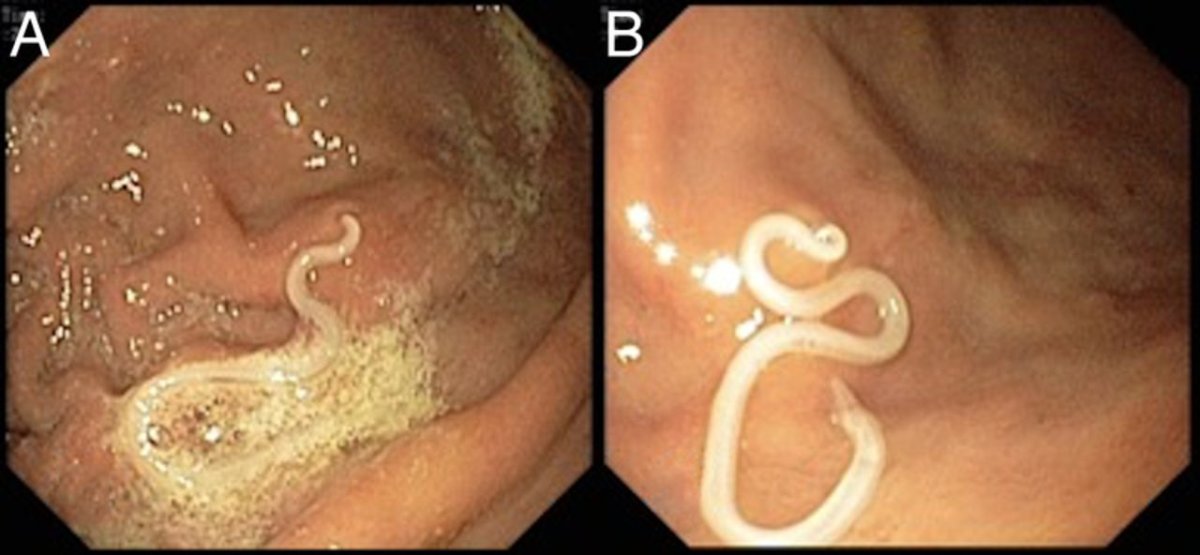After vomiting and grappling with a fever, an otherwise healthy 32-year-old man found out he had swallowed a parasitic worm that was in his sushi dinner.

The man had anisakiasis, an illness triggered by eating parasite-contaminated seafood. The parasitic worm latched onto his stomach lining and had to be removed with a special net, according to doctors who documented his case in BMJ Case Reports.
Now, the scientists who looked into the incident suggest that anisakiasis is on the rise in the Western world. It’s also known as herring worm disease, which is when parasites in seafood attach to the wall of the esophagus, stomach or intestine.
READ MORE: 5 things a Canadian food safety expert will never eat
“Gastrointestinal symptoms include abdominal pain, nausea and vomiting and complications like digestive bleeding, bowel obstruction, perforation and peritonitis can also arise,” the paper warned.
In this case, the man was dealing with gut pain, vomiting and a fever for about a week before he turned up in hospital. There, doctors out of the Hospital of Egas Moniz in Lisbon learned that he had eaten sushi.
READ MORE: Canadian man hospitalized after eating worms in homemade salmon sushi
His stomach was tender during physical examinations and his white blood cell count crept up, indicating an infection.
It was during an endoscopy, in which they used a flexible tube, light and camera that the doctors found the parasite attached to his stomach.
The U.S. Centers for Disease Control and Prevention is also warning that anisakiasis is on the rise in the Western world.
“Since undercooked fish is becoming more common, there have been cases seen in the United States, Europe, South America, and other areas of the world. Anyone who eats undercooked or raw fish or squid is at risk,” the federal agency says on its website.
READ MORE: Here’s why fruit smoothies are causing a hepatitis A outbreak in the U.S.
“Some people experience a tingling sensation after or while eating raw or undercooked fish or squid. This is actually the worm moving in the mouth or throat. These people can often extract the worm manually from their mouth or cough up the worm and prevent infection. Also, some people experience vomiting as a symptom and this can often expel the worm from the body,” the website reads.
Veteran food safety expert, Dr. Rick Holley, said that anisakiasis “could happen anywhere.” The study authors say the parasitic worms could infect salmon, herring, cod, mackerel or halibut.
READ MORE: Man complains of headache, doctors find tapeworm larva living in his brain
“It’s quite common … roundworms in fish species are something that you can come across even in the supermarket,” Holley said.
He said he’s found the worms while preparing meals of fish purchased in the supermarket.
“They’re easy to spot – about a centimetre to two centimetres,” he said. Sometimes, they’re moving but in other cases, they may curl into a ball and can easily be removed.
Cooking or freezing the seafood can also kill parasitic worms.
Holley doesn’t eat raw seafood at all. Other bacteria, from salmonella to vibrio, are more common occurrences he’s worried about.
READ MORE: 53 people in 9 states sickened after eating raw tuna
There are about 0.2 cases of trichinella, a parasite in raw pork, in 100,000 individuals, according to Holley. When it comes to E. coli, there are about 12 cases per 100,000. Norovirus affects about 3,200 people per 100,000.
Right now, anisakiasis cases are so minute, they aren’t even tracked, Holley said.
“To say it’s increasing may, in fact, be accurate but the numbers are still so small it’s pretty insignificant,” he said.
Health Canada says it “does not routinely collect” data on illnesses tied to raw seafood consumption, but it estimates that 18 per cent of all foodborne illnesses in the country are tied to seafood.
“There is a risk of foodborne illness due to bacteria, viruses and toxins associated with the consumption of raw and undercooked seafood. For example, shellfish, such as oysters, can be contaminated by bacteria, such as vibrio, parasites and viruses, such as norovirus before they are harvested,” Gary Holub, a department spokesperson, said in an email to Global News.
Read the full BMJ case report.
carmen.chai@globalnews.ca
Follow @Carmen_Chai





Comments